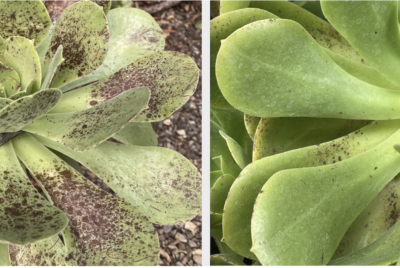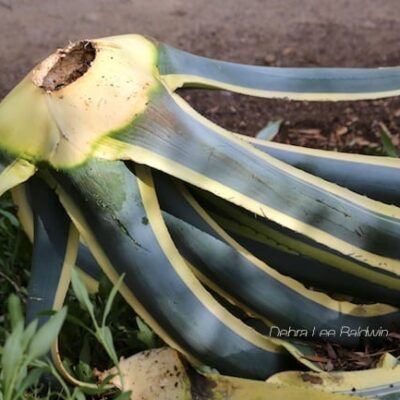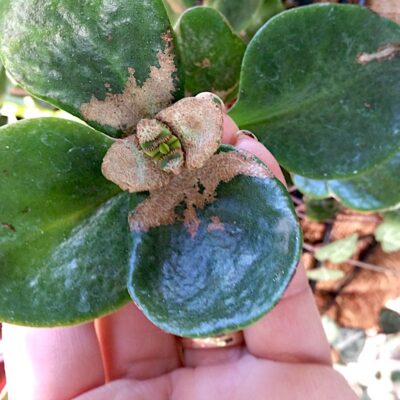
Recognize This Polka-Dot Succulent Pest?
A succulent pest that dots leaves with raised bumps recently showed up on this sempervivum. "Understandable if you audibly gasp," wrote its owner, who sent photos so I could identify it and suggest treatment.
I did gasp. It made the leaves look like dotted Swiss fabric. I had no idea, so I forwarded the photos to Annie Schreck, research director at a Northern CA nursery that offers dozens of varieties of semps: Mountain Crest Gardens.
Endophyllum sempervivi
Annie identified the disease as Endophyllum sempervivi. "It's not the most aggressive spreader," she replied, "but it is European and we don't need any more of it on this side of the Atlantic. I would burn all the affected plants."
It's a fungus similar to the "rust" that affects rose bushes. The Latin name suggests it's specific to sempervivums, so initially I assumed it wouldn't affect succulents in hot, dry climates like Southern CA's. However, a credible online source that Annie mentioned---Plant Pests of Europe---shows an infested aeonium, lists echeverias as susceptible, and adds, "It can destroy the plant."
Fortunately it's not especially aggressive. But it does spread, and can even be deadly. So if it pops up, don't bother treating it with fungicide. Bag the plant and put it out with the trash.

Hail damage on Aeonium 'Lily Pad'
Speaking of polka-dots
Every spring I get emails from people anguishing over spots on their succulents. For the most part, their plants are fine. It's ususally impact damage from winter storms. Shown here is my own Aeonium 'Lily Pad' which was about as beautiful as a succulent can be...before it got battered by hail. (I didn't expect hail in March, so I neglected to move its pot a few feet, beneath eaves.)
Especially susceptible are thin-skinned, soft or juicy succulents like echeverias, Agave attenuata, and Glottiphyllum linguiforme. Don't despair: They may look awful now, but by summer, new growth will hide most of the damage.

Above: Impact damage on aeoniums caused by a strong wind blowing small rocks. Right: Same plant with new growth. From my Succulent Pests, Diseases & Problems page.
Thanks to the Polka-Dot Pest...
This new malady made me want to update my popular YouTube succulent pest video, but unfortunately I no longer have the original file. Actually, the video's fine as is, except for the music. Back then I thought a video had to have music. Maybe it won't bother you.
Even better: Bookmark this site's continually-updated Succulent Pests, Diseases and Problems page. No...even better is that you never need it!
You know, I hadn't planned to become a succulent pest expert, but evidently it goes with the territory. Actually, I don't mind ID'ing diseases and problems, especially for cherished newsletter subscribers. Btw, if you subscribe, you'll be able to send me photos.
Just know that if you're outside my region, you may have a pest I've yet to see. This polka-dot fungus popped up in Oregon. So if/when you contact me, be sure to mention where you're located (city or region), OK?
Related Info on This Site
Uh-oh, Is My Succulent Sick? Common pests, diseases and problems, plus solutions
Succulent Pests, Diseases and Problems Keep your succulents healthy, happy and looking their very best WEEVIL ALERT: The agave snout-nosed weevil is a major pest in ever-increasing numbers. Don’t wait for signs of infestation; take preventative measures NOW to protect your agaves, furcraeas, yuccas, beaucarneas and mangaves. Please don’t let your yard become a breeding ground for pests that move…
Succulent Pests and Problems Q&A Forum
Are pests or mysterious maladies causing problems with your succulents? This page is a forum for you to ask questions, leave comments and share what works for you. Others can see and benefit from the answers. Your own tried-and-true solutions are welcome, too!



We have a lot of succulents with the polka-dot measle pattern. I’ve tried antifungals on them recommended by our neighbor who has owned a nursery for 40+ years, but I think we put too much of the powder on them as it kind of ate through the petals. It was hard to rinse off too when I decided to rinse it off of some of the other ones we used it on. We live in Southern California (Valley Center).
Yikes, Valley Center!? We’re in the same Zip Code!
Try spraying Neem oil on them. This stuff is wonderful.
I have these dents in my hens and chicks that I have never seen before!! Any idea what it could be?
Hi Sheila, from the photo you sent me in response to my newsletter, it’s hail.